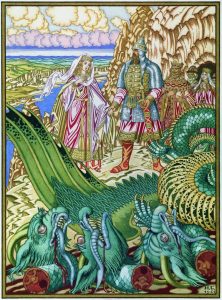MDA in Photopia and Menu-based Interactive Fiction
“It’s like everyone tells a story about themselves inside their own head. Always. All the time. That story makes you what you are. We build ourselves out of that story.”
Comparing Photopia and a game like Choice of the Dragon feels like comparing Schindler’s List to Big Trouble in Little China, both great but aside from the medium they share, they are different in just about every way from the inside out. I would however, put forth the idea that menu systems verses parsers have very little to do with the major stylistic difference, so much as the stories themselves, or in other words, it’s about the difference between Aesthetics not Mechanics.
Mechanics:
Photopia is a nonlinear parser, which tells a huge ensemble story by switching between its many protagonists, all revolving around a young woman named Alley. You type in commands and attempt to interact with the environment, sometimes you’re in a made up fantasy world and have to find your way out, other times you’re simply driving, waiting for time to pass until the story itself takes you to the next event/character.
Choice of the Dragon is a horse of a different color, it’s a menu-based system where you select your choices as opposed to typing them in. Despite sounding more limited, Choice of the Dragon ends up being the far more open ended game. You control an up and coming dragon trying hard to establish dominance in the land either through cunning, honor, vigilance, or disdain. The story can go quite a few different ways depending on how you want your dragon to end up.
Dynamics:
Choice of the Dragon and Photopia are both quite good about sucking you into their worlds. Time passed as I played both games and I forgot where I was — I was simply absorbed. Neither game is really a struggle to play, Photopia will straight up give you the answer to solutions if you wait around enough. Choice of the Dragon similarly is only hard if your dragon lacks the necessary stats. As long as you play up the right stats you can handle any situation, whether it be a knight coming to claim your hoard or a rival dragon on the rise. Again, reinforcing the idea that Dragon is about you and your character, whereas Photopia is about a character—Alley.
Aesthetics:
Photopia is certainly a cut above the usual text adventure, because at the end of the day its all about Alley not you. Each stage or level feels like uncovering a mystery, not creating your own story. That is ultimately why it is a linear story, not out of laziness but to lock you in a certain mindset. Every character and their scene is only significant in their relevance to Alley; a young woman who meets an untimely death. It’s about who she was, and how her life was cut short. Choice of the Dragon, like the Patrick Rothfuss quote is more concerned with you, the player. Who are you? What does your dragon say about you? To use a metaphor, if Photopia is a painting, than CotD is more like a mirror. That being the case I would place CotD assuredly into Games as Expression, as it functions to help us reveal ourselves while Photopia is almost certainly an example of Games as Narrative. It’s a front seat to a spellbinding drama about other people, their problems, and ultimately their life lessons. But Games as Fantasy is also applicable here because both put you in the shoes of fantastical characters, although Photopia only does so for portions of its tale, while the rest is grounded in heady realism.

